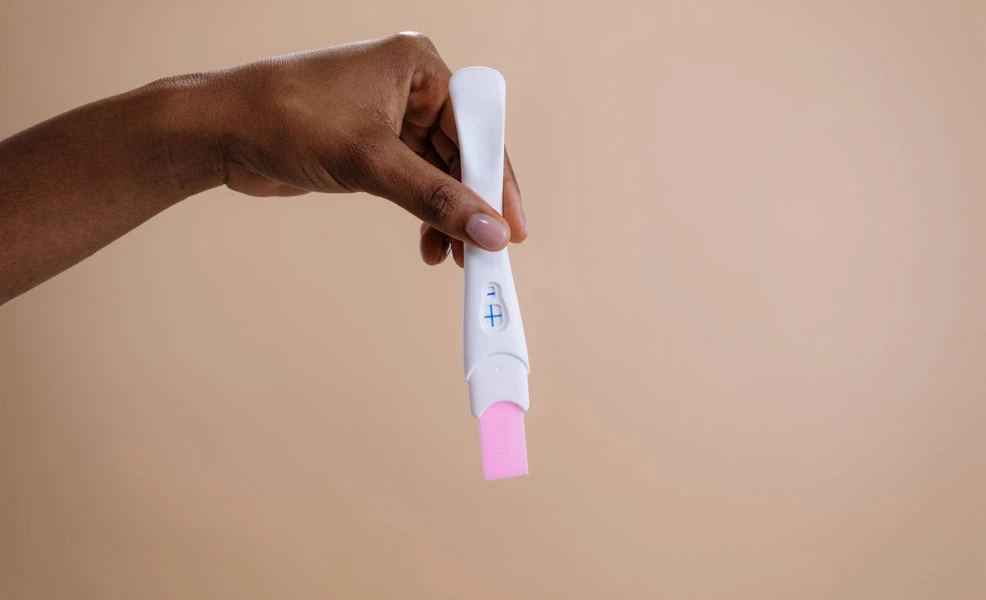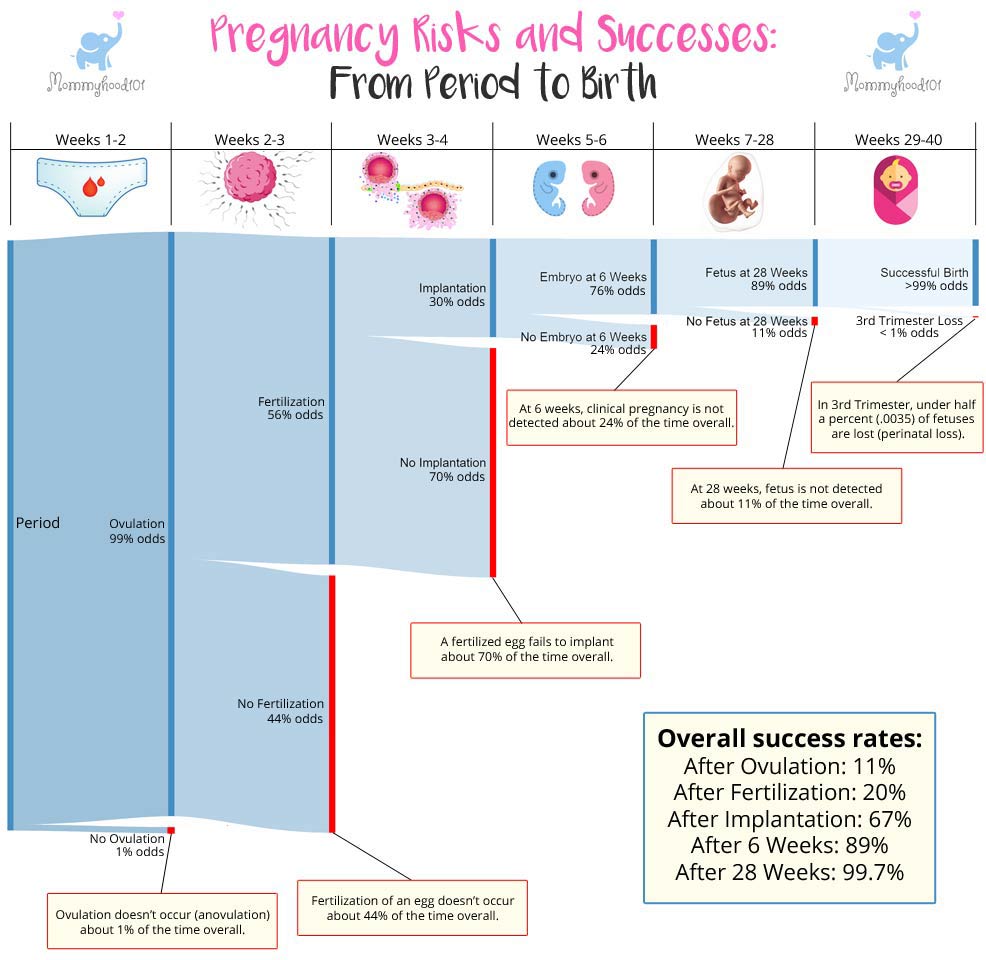From ovulation to birth - learn the pregnancy odds at each stage of the process!

Mommyhood101 independently tests and curates baby gear to help you make informed decisions. If you buy products through links on our site, we may earn a commission.
Getting pregnant involves a complex dynamic between the woman's body and the man's sperm, and a cascade of genetic, hormonal, and metabolic processes determine whether you get pregnant and carry your baby to term.
What are the odds of getting pregnant? How do those odds break down into ovulation, fertilization, implantation, embryo development, and fetal development through the first trimester, second trimester, and third trimester of pregnancy? We reviewed the scientific literature, analyzed the data, and figured out how the likelihood of a successful pregnancy changes over time.
The Odds of Getting Pregnant
Decades of research have demonstrated the approximate likelihood of each phase of pregnancy, but very few recent publications have pulled together all of those data into a single comprehensive understanding of how the risks and successes of pregnancy change over time.
To figure out the odds associated with each phase of pregnancy, we pulled together 8 scientific studies that have been published on the topic (see Reference section).
We calculated the average probabilities associated with each phase of pregnancy, and did the math to make you a chart explaining the risks associated with each phase of the process.
From your period to childbirth, the overall odds of getting pregnant and carrying a baby to term are about 11.2% overall. That seems pretty low, right? That's why it's important to detail what happens along the way, to give you a clear picture of how those probabilities change over the course of 40 weeks.
Before we present you with the data, we want to be clear about certain assumptions we are making about you, your partner, and your current situation. To review those assumptions, scroll down to the Assumptions section.
The Odds of Ovulation
Assuming you have had your period, the probability of ovulation is very high, about 99%. You will likely ovulate about 14 days after the first day of your period (see our ovulation calculator here). This means that your body will release an egg that becomes a candidate for fertilization (Ref 1).
The Odds of Fertilization
Assuming you are ovulating and have intercourse resulting in ejaculation, the odds of a sperm fertilizating your egg are about 56%. That means that in most cases, a sperm will successfully fertilize your egg. Only in about 44% of cases will a sperm not reach your egg (Refs 2, 3).
The highest probability of fertilization occurs on the day of ovulation. But because sperm can survive for about 5 days in your uterus, the fertile window extends from about 9 days after the first day of your period, for about 6 days. Thus, intercourse during the 5 days preceding ovulation, and the day following ovulation, can result in fertilization.
The Odds of Implantation
Assuming you have successfully fertilized your egg, the probability of implantation is about 30%. This is the lowest probability of any phase, making it the biggest bottleneck to a successful pregnancy (Refs 1, 4).
The good news is that once your egg successfully implants into the wall of your uterus, the likelihood of making it to term are pretty high (about 67%). A gambler would take those odds any day!
The Odds of Making it to 8 Weeks Pregnant
Once your egg has successfully implanted itself and divided into the beginnings of an embryo and placenta, the odds of making it to the 8 week mark (or the first ultrasound) are about 76% (Refs 1, 4).
If you have an early ultrasound at 8 weeks, your doctor will be able to hear a heart beat, take measurements, and calculate a due date.
The Odds of Making it to 28 Weeks Pregnant
Once your egg has become an embryo, the odds of making it to 28 weeks pregnant are about 89%. This is the first point at which your baby becomes viable for a preterm birth, with an extended stay in the neonatal intensive care unit (NICU) (Refs 1, 3).
The Odds of Making it through the Third Trimester
Once you make it past the 28-week mark, the odds of your baby making it through the third trimester are very high, greater than 99%. While perinatal deaths are very rare, they do happen in less than 1% of pregnancies, and can be devastating for parents (Refs 5, 6, 7).
Use our calculator to predict what your baby might look like!
Pregnancy Odds Infographic
Here is our popular (and awesome!) infographic depicting the probability of a successful pregnancy, from ovulation to birth.

Important Assumptions
Assumption 1: You (the woman) are between the ages of 18-30. As women grow older than 30, the probabilities change. As men grow older, this also changes the probabilities. We have not done the math to figure out exactly how that affects our results, because the data are not fully available to make those calculations.
Assumption 2: You and your partner will have sexual intercourse (ending in ejaculation) during your fertile window, and most importantly on your day of ovulation. To learn more about the fertile window, check out our article about the first trimester of pregnancy.
Assumption 3: All women and men are different, and the statistics we present are averaged across thousands of partners attempting to get pregnant. Partners may or may not have medical or genetic histories that can impact their likelihood of getting pregnant and maintaining a pregnancy.
The data we present are the averages, that consider large samples of the population, and should not be used to figure out YOUR probability of getting pregnant and maintaining your pregnancy through to childbirth. They are just averages, and your situation might be very different.
References
1. Wilcox, A. J., Weinberg, C. R., & Baird, D. D. (1995). Timing of sexual intercourse in relation to ovulation—effects on the probability of conception, survival of the pregnancy, and sex of the baby. New England Journal of Medicine, 333(23), 1517-1521. https://www.nejm.org/doi/full/10.1056/NEJM199512073332301
2. Schwartz, D., MacDonald, P. D. M., & Heuchel, V. (1980). Fecundability, coital frequency and the viability of ova. Population Studies, 34(2), 397-400. https://www.tandfonline.com/doi/abs/10.1080/00324728.1980.10410398
3. Wilcox, A. J., Dunson, D., & Baird, D. D. (2000). The timing of the “fertile window” in the menstrual cycle: day specific estimates from a prospective study. Bmj, 321(7271), 1259-1262. https://www.bmj.com/content/321/7271/1259.short
4. Boklage, C. E. (1990). Survival probability of human conceptions from fertilization to term. Int J Fertil, 35(2), 75. https://pubmed.ncbi.nlm.nih.gov/1970983/
5. Yudkin, P. L., Wood, L., & Redman, C. W. G. (1987). Risk of unexplained stillbirth at different gestational ages. The Lancet, 329(8543), 1192-1194. https://www.sciencedirect.com/science/article/pii/S0140673687921544
6. Naeye, R. L. (1977). Causes of perinatal mortality in the US Collaborative Perinatal Project. Jama, 238(3), 228-229. https://jamanetwork.com/journals/jama/article-abstract/354355
7. Ogunyemi, D., Jackson, U., Buyske, S., & Risk, A. (1998). Clinical and pathologic correlates of stillbirths in a single institution. Acta obstetricia et gynecologica Scandinavica, 77(7), 722-728. https://www.tandfonline.com/doi/abs/10.1080/j.1600-0412.1998.770705.x






